Synopsis:
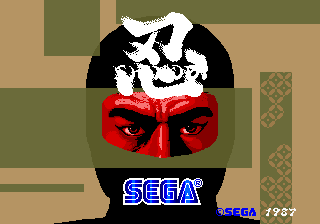 The original Shinobi is a perfect example of pure genius in game design. Contrary
to popular belief, such perfection is not ineffable. Shinobi begins with a lot
of similarities to games such as Bad Dudes and the later Altered Beast, as well
as having similarities with numerous run-n-gun style games. When a player in
1987 popped in a quarter for the first time, he would feel immediately familiar
with the controls, hold right, press one button to shoot shuriken, another to
jump, and watch for power ups. However, those similarities only go so far due
to Shinobi's numerous innovations and excellent execution.
The original Shinobi is a perfect example of pure genius in game design. Contrary
to popular belief, such perfection is not ineffable. Shinobi begins with a lot
of similarities to games such as Bad Dudes and the later Altered Beast, as well
as having similarities with numerous run-n-gun style games. When a player in
1987 popped in a quarter for the first time, he would feel immediately familiar
with the controls, hold right, press one button to shoot shuriken, another to
jump, and watch for power ups. However, those similarities only go so far due
to Shinobi's numerous innovations and excellent execution. Like Bad Dudes, Shinobi has two levels to fight on, the ground and typically the top of a wall or other object standing in the background or foreground. In the process of working your way past armed gunmen, ninja's and the like, giant warriors with shields known as Mongo must either be defeated or circumvented in an effort to rescue their good ninja hostages. All enemies can be defeated by frontal attack or by 'stealth' of a sort by leaping up or down from another level behind the unsuspecting enemy. Hostages can also be rescued by stealth rather than force by simply jumping up or down to them and then immediately retreating back to the other level. Rescuing hostages results in numerous power ups for long and short range weapons which increase the power and effectiveness of your attacks.
Unlike Bad Dudes, enemies are not constantly running from one end of the screen to another shelling out cheap shots and getting clobbered by button mashing. Shinobi is a one-hit and you die game, and this when combined with the variety of enemy designs makes for a much more sophisticated game. Requisite thugs in the first level will run straight at you and attempt to knife you first, while gunmen will be standing, kneeling or laying when they come on screen, and you must either dodge bullets in order to kill them, or retreat to another level to get closer before making the kill, and the variety of ninja which appear out of thin air are something else entirely. Green ninja may run straight at you, or may jump to another side, or retreat to a different level in an effort to attack you off guard while you're occupied with another enemy. Blue Ninja frequently show up in greater numbers, and primarily leap off the screen only to land sword down on your position a second later. Those are only the basic enemies, but adding the fact that you are often times fighting all of them at once makes proper strategy a must in this game.
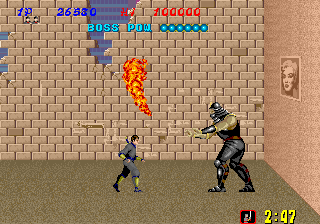 The bosses are certainly no pushovers either, having to fight a dual fireball
throwing Shredder look-alike (before TMNT ever existed), a helicopter with blue
ninja jumping out of it, or Level 3's Mandara boss are all likely to be challenging
experiences for many plays. The addition of screen clearing Ninja Magic is very
necessary for novice players, but offers an additional point bonus if the player
completes a level segment without using it. The player will also receive a point
bonus for completing a segment without shuriken, using only close attacks instead,
making the highest score possible much higher than the average player could
manage.
The bosses are certainly no pushovers either, having to fight a dual fireball
throwing Shredder look-alike (before TMNT ever existed), a helicopter with blue
ninja jumping out of it, or Level 3's Mandara boss are all likely to be challenging
experiences for many plays. The addition of screen clearing Ninja Magic is very
necessary for novice players, but offers an additional point bonus if the player
completes a level segment without using it. The player will also receive a point
bonus for completing a segment without shuriken, using only close attacks instead,
making the highest score possible much higher than the average player could
manage.Sega was thoughtful on the difficulty, which is self scaling, and the game rewards the player for playing better. Once you rescue a hostage, that hostage stays rescued and his Mongo guard is gone as well, even if you have to start the level over. By doing this the player is not required to restart the level proper, but merely has to fight the regular enemies back to the area where he was defeated. However, any power ups gained throughout the level up until that point will be lost, and will not be gained again in that level segment, but power ups cannot be brought to the boss fights anyway. Boss fights themselves scale in difficulty, with the first fight having nearly double the energy level as subsequent retries would have. Finally, the Bonus Rounds, which offer the player additional lives, are necessary to master in order to beat the fifth and final level, which does not allow you to continue. All of this creates a game environment friendly to the beginner, rewarding to play over and over, and very difficult to master. A player who can beat this game at all is skilled, but a player who can beat all five levels with one continue is truly a master.
Facts and Release Dates:
The arcade game is 1024 Kilobytes, the equivalent of an 8 Megabit cart such as Strider on the Genesis in size. The PC-Engine game is 384 Kilobytes, which is a 3 Megabit card, smaller than the Genesis versions of Altered Beast, Golden Axe, or Revenge of Shinobi. The Master System and NES games are 257 Kilobytes, which are 2 "Mega" bit cartridges. The lack of an entire level and several enemy types in the PC-Engine game need not be attributed to sloppy programming on Asmik's part. The fact that the PC-Engine version has at least twice the animation and colors on screen at all times than the SMS and NES versions is amazing in light of the card only having 1.5 times the memory to work with. Similarly, the comparison between the PC-Engine version and the Arcade version favoring the Arcade in colors, scrolling backgrounds, enemy characters, and the presence of Level 2 can be attributed to the Arcade ROM having an extra 640 Kilobytes, or 5 Megabits, to work with.
While the PC-Engine would eventually be capable of 16 Megabit game cards, this was not an option at the time of this game's release. Memory was very expensive prior 1989, and Sega was the only company offering 4 Megabit carts up until that point, which frequently cost more at retail than normal size carts of 1-2 Megabits. The first cartridge game to enjoy the relative roominess of 8 Megabits was Strider in the US in September of 1990, and the first card game to reach 8 Megabit was the SuperGrafx version of Ghouls N Ghosts in Japan in July of 1990. So attempting to make a home conversion of that size in 1988-89 was just not feasible. Apparently making them all 4 Megabits was too much to ask for as well, but this certainly would have made significant differences in each game. The PC-Engine version came out in 1989, the same year as the NES game did and the NES game appears to be a port from the SMS version, which came 2 years before both.
Graphics:
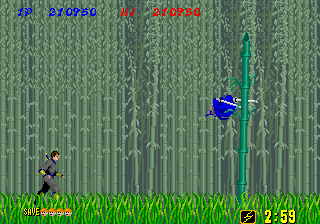 The differences are easy enough to see in screenshots. The comparison goes downhill
in color count from the Arcade, to the PC-Engine, to the SMS, with the NES being
the lowest color count possible, as should be expected. The Arcade game is the
only one with two scrolling planes, one for the ground and a separate plane
for the far background, with the home ports of the game having only one scrolling
plane. The Arcade and PC-Engine games share almost 100% percent of the animation,
while the SMS and NES versions don't animate like the Arcade version at all,
with the SMS game having more frames of animation than the NES game.
The differences are easy enough to see in screenshots. The comparison goes downhill
in color count from the Arcade, to the PC-Engine, to the SMS, with the NES being
the lowest color count possible, as should be expected. The Arcade game is the
only one with two scrolling planes, one for the ground and a separate plane
for the far background, with the home ports of the game having only one scrolling
plane. The Arcade and PC-Engine games share almost 100% percent of the animation,
while the SMS and NES versions don't animate like the Arcade version at all,
with the SMS game having more frames of animation than the NES game. Level design differences:
Level 1 is virtually identical in all versions, though gameplay differences exist in the NES game due to flaws that will be discussed later.Level 2:
The PC-Engine game does not have this level in it, while the Arcade and SMS version are virtually identical in design. The NES game's round 2_2 only has one level, while the SMS and Arcade versions travel up several levels to the end.
Level 3:
Virtually identical in the Arcade, PC-Engine and SMS versions, while the NES version's 3_2 only has one level, and does not travel up or down as the original does. There is a new enemy, a Bazooka carrying soldier, that is only in the Arcade, SMS and NES versions of the game, and is not in the PC-Engine game. Instead, the PC-Engine version substitutes a new palette swapped ninja which does not attack differently than other ninja. The boss fight is also significantly different in the PC-Engine game, as the Mandara boss's protective statues are only one level, rather than stacks of five as the other versions have. They compensated for this by making the individual statues harder to defeat.
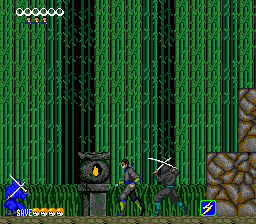 Level 4:
Level 4:This level is virtually identical in design in all versions, with very little level design differences. There is an undead samurai character in the first part of this level that does not appear in the PC-Engine version, and the jumping frogmen in the two middle levels are replaced by green "spiderman" ninja's in the PC-Engine version. The Lobster boss fight is different in the SMS and NES version than the Arcade game in that he only walks towards you at the same pace while swinging his sword from the wrists at a consistent interval. The PC-Engine version is closer in that he will dash away from you at times, and keeps his guard up by his head as he does in the Arcade game unless he's taking a swing at you. The Arcade version is more difficult because Lobster will run at you quickly to swing at you, and you must hit him in the head while running to stop him from killing you.
Level 5:
I have not completed Level five in any version, the bamboo thickets and super flying ninja of 5_2 polish me off every time. However, the only significant difference between the home versions is the addition of a new enemy character in Level 5_3 which is a bo carrying Samurai type, replaced by another palette swapped ninja in the PC-Engine game. Also, the Masked Ninja boss fight is significantly more difficult in the PC-Engine game due to him varying his pace, and his odd reaction to Ninja Magic. Both the NES and SMS games have the Masked Ninja simply jumping at you, and providing a simple pattern of being vulnerable before a jump. I have not seen the Masked Ninja boss fight in the Arcade version, to make a comparison.
Audio:
The Arcade version is the only one with digital voice which is a major part of the experience, all of the other home versions use analog sound effects in place of the voices, and make no attempt to emulate them. The PC-Engine game is the best of the three home versions in audio, with music that is extremely close to the Arcade original, and being the only version to have all of the Arcade game's music. The Sega Master System game is limited to only BGM_A, the Boss fight music and the Bonus round music. The NES game plays BGM_A through the levels and the boss fights, and also has Bonus round music.
Gameplay:
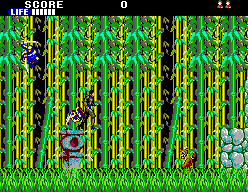 PC-Engine:
PC-Engine:The PC-Engine game has no power ups, no close-in attack animations, no Level 2, and no Bonus Rounds. Whether this is a crippling limitation of this version is entirely up to the individual player, as the PC-Engine version is also the only version with the arcade version's sprites, animations, music, and has the best resemblance to the Arcade game overall. The lack of power ups doesn't affect gameplay as much as one might think, but it does limit the game's replayability and increase the challenge level. The lack of close-in attacks is the most crippling loss, next to the loss of Level 2. Fighting ninja becomes incredibly difficult when all you can do is throw shuriken at them until they drop their guard to attack, when in the other versions you can just get in close and beat them to the attack. With the addition of boss fight patterns not present in the other home versions, and the overall feeling of similarity with the Arcade version, the argument for this version being a good additional copy of the game can easily be made. Fans of Yuzo Koshiro music should find this version a must, as it's got all of the good music over the other home versions.
Sega Master System:
The SMS game is a very faithful translation of the original Arcade title, but is limited significantly by the cart size and 8-bit nature of the system. Graphics, especially animation, and sound suffered the most in this version. However, this version has the addition of an increasable energy bar, added power ups such as the nunchaku and ball and chain close weapons, and high jumping ninja magic, that the PC-Engine and Arcade games do not have. The addition of the energy bar is supplemented with the added difficulty of losing energy with most collisions with an enemy, while the arcade and PC-Engine games allow you to bounce off the top of most enemies, which can position you better for a quick kill. These additions make for a much more interesting home title that would otherwise not have been possible on 8-bit hardware.
NES:
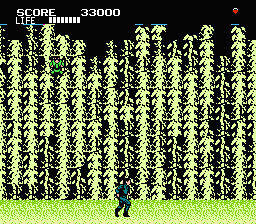 The NES game is a port of the SMS game, and as such contains many of the additional
gameplay aspects, but none of the polish of the SMS game. Most glaring amongst
its flaws is that enemies will attack you while you're jumping up or down from
a different layer, while the other versions give you a split second to at least
move before they start shooting. This means that if you jump up in front of
another character, it will hit you before you land almost every time. Secondarily
to that flaw is that your character will get stuck inside enemy sprites and
simply bounce around while losing energy, and this usually does not stop until
the energy bar is depleted. This almost entirely negates the usefulness of the
energy bar, as one hit will often times result in eventual death due to being
bounced around without end. The SMS game allows an instant to move after being
bounced off an opponent.
The NES game is a port of the SMS game, and as such contains many of the additional
gameplay aspects, but none of the polish of the SMS game. Most glaring amongst
its flaws is that enemies will attack you while you're jumping up or down from
a different layer, while the other versions give you a split second to at least
move before they start shooting. This means that if you jump up in front of
another character, it will hit you before you land almost every time. Secondarily
to that flaw is that your character will get stuck inside enemy sprites and
simply bounce around while losing energy, and this usually does not stop until
the energy bar is depleted. This almost entirely negates the usefulness of the
energy bar, as one hit will often times result in eventual death due to being
bounced around without end. The SMS game allows an instant to move after being
bounced off an opponent.Conclusions:
Obviously the Arcade title reigns supreme, even compared to other games in general. Few games approach its beautiful level of gameplay complexity and polish, least of all in the 3D generation of consoles and arcade titles. Beyond that, playing Shinobi via MAME is only a partial solution, because the availability of save anywhere slots makes for a totally different experience that almost eliminates the innovations Sega made in the area of scaleable difficulty.
Among the home versions, it is a toss up between the 1987 Sega Master System game, and the 1989 PC-Engine game. These two also absolutely must be played outside of emulation to be truly appreciated, as the temptation to save and ruin the gameplay balance will ultimately ruin the experience for most players. Replaying either home version from the beginning, and mastering each level is the core of Shinobi, and the timing of each version is very specifically set to make it possible to master either version. Owners of the SMS version can rest assured that they have the version with the most faithful gameplay of all home versions, while PC-Engine fans can enjoy an experience which looks and feels closer to the Arcade game most of the time.